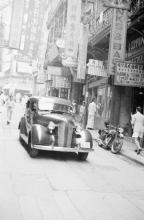Artillery Observation Posts in Hong Kong
Primary tabs
As we've been looking for pillboxes, we've found a few that didn't seem to fit the pillbox pattern. Generally they were on high ground where pillboxes are low down, and had much larger window openings than the pillboxes' small loopholes.
Later it seemed possible they were Artillery Observation Posts (AOPs), rather than pillboxes. Rob Weir, expert on Hong Kong's wartime fixed defences, has confirmed our guess, and given us plenty of extra information about them:
From the information I have, they were lookout positions for the Artillery Observers to control Flash Spotting and Counter Bombardment. I don't know how many personnel may have manned them, or what equipment they may have had for the purposes.
They were divided into two groups, Eastern and Western, controlled from the corresponding Artillery HQ's.
Eastern Group were:
- Braemar Hill (1)
- Pottinger Peak (2)
- Mt Parker (1)
- Red Hill (?)
- Stanley Mound (2)
- Jardine's Lookout (1)
Western Group:
- Victoria Peak (2)
- High West (2)
- Matilda (2)
- Middle Spur (2)
- Mt Nicholson (1)
- Kennedy Town (?)
- Wan Chai Gap (1)
There are two different types which I have shown as ( ) purely to differentiate them. Dimensionally they are identical, the main difference being whether they have one or two openings at the front. In either case, this was protected by outward opening hinged metal shutters, and the distinctive "eyebrow" above.
The entrance had a single metal door, similar to a Pillbox door, and has been seen on either side or the back. An airshaft, again similar to those of PB's and Shelters, was at the back corner of the roof.
All the sites are shown in: WO 106/2379, Hong Kong Interim Defence Plan, held at the National Archives in Kew. They are not all listed in the same sections/paragraphs, and sometimes it gets to be a cross-referencing nightmare, but having gone through my notes closely I found references (but not positions) to all.
We've found several already (see the list on the left, and the map below). Rob has kindly given directions to the others:
- Mt Parker - above Mt Parker Road just below the "Golf Balls".
- Red Hill - not found, possibly demolished during slope reconstruction above the housing development.
- Stanley Mound - now the base of the lookout on Wilson Trail above Stanley Gap Road.
- Victoria Peak - within the telecom compound, north side of Victoria Peak.
- Matilda/Mt. Kellett - roughly 200 metres south of Matilda Hospital.
- Middle Spur - near the small service reservoir north of Belleview Drive, east of Repulse Bay Road.
- Kennedy Town - not found, suspect it was in the old Observation Posts on Lung Fu Shan.
- Wan Chai (Gap) - just below northern side of Black's Link not far from Wan Chai Gap.
- Mt. Nicholson - lower slope of Mt. Nicholson, just south of 103 Mt. Nicholson Road.
If you visit others, please can you add a new place, and give it the tag artillery observation post.
Elsewhere I'd read about 'Fortress Observation Posts', and asked Rob if these were the same as AOPs. Rob's reply:
The AOP's and Fortress Rangefinding System are two entirely separate animals. The AOP's were for the mobile artillery - 3.7", 4.5" and 6" howitzers. The other was for all the coast defence artillery - 9.2", 6" etc.
There were a number of Fortress Observation Posts (FOP) around the coast - 2 on the Clearwater Bay Peninsular, and one on Tung Lung Island as examples. They observed range and bearing to targets, fall of shot and target behaviour for the Fortress Plotting Room (FPR) which co-ordinated with the Battery Observation Posts (BOP) at the various batteries to determine which guns should engage respective targets.The FPR's were originally at Tai Tam and Mt Davis, but the Tai Tam one was shifted to Stanley Fort when it was built.
That's a pretty potted story. The Fortress system was a highly integrated and complicated one, with a lot of plotting equipment and personnel. There are still a lot of the buildings surviving, although in derelict condition.
And finally, a little more about Rob's comment that the AOP's were for 'Flash Spotting and Counter Bombardment'. In the days before satellites and high-tech warfare, simpler methods prevailed. One of the roles of artillery was to try and put the other side's artillery out of action, ie Counter Bombardment. Of course first you had to find where they were, and one method was to watch for the flash made when they fired their guns, ie Flash Spotting.


Comments
Map of AOPs
Here are the places for AOPs that have been created so far. For more information about a place, click its red marker on the map. Your are welcome to add another place - just remember to give it the tag Artillery Observation Post so that it shows up on the map below.
The map below is 'live': you can drag it around with your mouse, click the +/- buttons to zoom in and out, and click the Map/ Satellite/ Hybrid buttons to change the appearance of the map.
Clearwater Bay AOP
Was there a set amount of floors for an AOP? Ive photographed one I found in clearwater bay and just trying to clarify dimensions.
re: Clearwater Bay AOP
Hi, All the AOPs we've seen have been a single storey high.
However, I think the building you're interested in was one of the Fire Control Sites, see: http://gwulo.com/node/11929
I don't know if they were one- or two-storeys high.
Regards, David